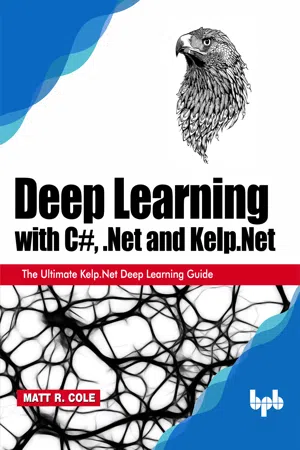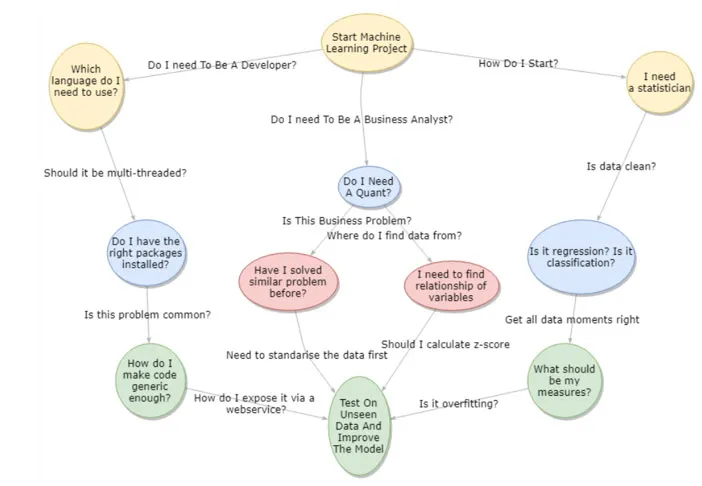
Deep Learning with C#, .Net and Kelp.Net
The Ultimate Kelp.Net Deep Learning Guide
Matt R. Cole
- English
- ePUB (disponibile sull'app)
- Disponibile su iOS e Android
Deep Learning with C#, .Net and Kelp.Net
The Ultimate Kelp.Net Deep Learning Guide
Matt R. Cole
Informazioni sul libro
Leverage SharePoint Online Modern Experience to create beautiful, dynamic and mobile-ready sites and pages Description
Lots of small, medium and large organizations or enterprises are using Office 365 for their business. And Microsoft is also investing heavily on Office 365 and providing lots of new features in Office 365 and other services in Office 365 like Office application or SharePoint Online, Yammer, Teams, Flow or PowerApps, etc. SharePoint is one of the popular portal technologies and web-based business collaboration and document management system. With Office 365 subscription, organizations can use SharePoint Online. Microsoft has announced the Modern features in SharePoint for a long time. Modern Experience is the future of SharePoint Online and on-premises also. This book is a comprehensive guide that lets you explore the Modern features in SharePoint Online or SharePoint Server 2019. In the book, I have covered details on Modern Team sites, communication sites, how you can customize the team sites according to your business requirement. You will also get hands-on Experience on how you can customize Modern site pages. I have also explained in detail various new features of Modern list and document libraries in SharePoint. This book also contains a few SharePoint portal examples, you will get in-depth knowledge on how to design team sites with various useful web parts. Few Organizations are still using SharePoint On-premises versions like SharePoint server 2019. I have also explained the Modern Experience in SharePoint 2019. Always it is better to know also, what are the things which are not possible in SharePoint Modern Experience, based on which you can check the impact, before moving to the SharePoint Online Modern Experience. Audience
This book is for the site owners, power users or administrators who want to design attractive pages for SharePoint Modern team sites or publishing sites. Though the book is intended for SharePoint developer knowledge, but a little understanding of SharePoint is required. We have provided detailed steps with proper screenshots for references. This book is also for the developers who are trying to build pages for Modern SharePoint team sites or publishing site in SharePoint Online or SharePoint server 2019. What you will Learn
In this book, you will learn what are Modern Experiences in SharePoint. How we can handle at the organizational level. What are the things which are not possible in SharePoint Online Modern Experience. Various new features of SharePoint Online Modern list and document libraries.You will also learn various web parts and how we can use those web parts while designing pages for your sites. Various examples of SharePoint Modern portal designs. How we can create and customize Modern site pages. How we can also start with SharePoint Server 2019 and use various Modern web parts in SharePoint 2019 sites. Key Features
- Learn how to use SharePoint Online Modern Experience (Modern UI)
- Create a Modern team site and communication site for your organization in SharePoint Online or SharePoint Server 2019
- Effectively use Modern list and Libraries in SharePoint Online or SharePoint 2019
- Learn about various Modern SharePoint web parts
- Create attractive and responsive portals in SharePoint Online or SharePoint 2019
Table of Contents
- Data Science Fundamentals
- Installing Software and Setting up
- Lists and Dictionaries
- Function and Packages
- NumPy Foundation
- Pandas and Dataframe
- Interacting with Databases
- Thinking Statistically in Data Science
- How to import data in Python?
- Cleaning of imported data
- Data Visualization
- Data Pre-processing
- Supervised Machine Learning
- Unsupervised Machine Learning
- Handling Time-Series Data
- Time-Series Methods
- Case Study – 1
- Case Study – 2
- Case Study – 3
- Case Study – 4
- About the Author
Bijaya is a Microsoft MVP (Office Servers & Services) and having more than 11 years of experience in Microsoft Technologies specialized in SharePoint. He is Co-founder of TSInfo Technologies, a SharePoint consulting, training & development company in Bangalore, India. He has been a technology writer for many years and writes many SharePoint articles on his websites SharePointSky.com and EnjoySharePoint.com. Bijaya is a passionate individual who loves public speaking, blogging and training others to use Microsoft products. Before co-founding TSInfo Technologies, he was working with small and large organizations in various SharePoint On-premises as well as SharePoint Online office 365 & various related technologies. Bijaya also likes to publish SharePoint videos on his EnjoySharePoint YouTube Channel.
Domande frequenti
Informazioni
CHAPTER 1
Take This ___
and ___ It
| 1. | My boss wanted to use machine learning to solve problems, but of course, none of our projects have really good problem definitions. |
| 2. | My boss, as well as the rest of the senior management, has been told how simple yet important deep learning is. We cannot let our competitors go ahead of us. “Just a combination of massive amount of data, cloud technologies and coding,” he said. How hard is it in my corporate world to request even the smallest amount of data from an external owner, yet now I need access to reams and reams of it across multiple owners? Hopefully, he and others will understand that to do this properly, we will need to spend a considerable amount of time locating, cleaning and preparing the data to be useful for this project, and that is before we even start coding! First, however, is getting the permissions from each data silo owner to access the data. |
| 3. | Once I do get access to the 75 petabytes of data the company has been storing for 15 years, how in the world am I going to fit it into this wonderful, third hand-me-down laptop that IT support has given me? 2 GB RAM was the standard 10 years ago, but not really sure if the machine learning objective is going to work out so well like this. I will surely have a lot of time to start drinking coffee! |
| 4. | I tried and let our data scientist team know why we might need to consider some alternative routes, but of course that explanation fell on deaf ears because they all have PhDs! |
| 5. | Our models do and will fail while we are perfecting them, and that is an iterative part of how we make things work. This was going to be fun when confronted with why is it failing and trying to explain it to the upper management! I was hoping that the new data science team would be there to help explain to my boss why model failure is a part of the process, but they were insisting that we rewrite everything in R or Python because that is what real deep learning projects use. |
Objectives of this book

Indice dei contenuti
- Cover
- Deep Learning with C#, .NET and Kelp.NET
- Copyright
- About the Author
- Reviewer
- Preface
- Acknowledgement
- Errata
- Table of Contents
- 1. Take This ___ and ___ It
- 2. Machine Learning/Deep Learning Terms and Concepts
- 3. Deep Instrumentation Using ReflectInsight
- 4. Kelp.Net Reference
- 5. Model Testing and Training
- 6. Loading and Saving Models
- 7. Sample Deep Learning Tests
- 8. Creating Your Own Deep Learning Tests
- Appendix A
- Appendix B
- OpenCL